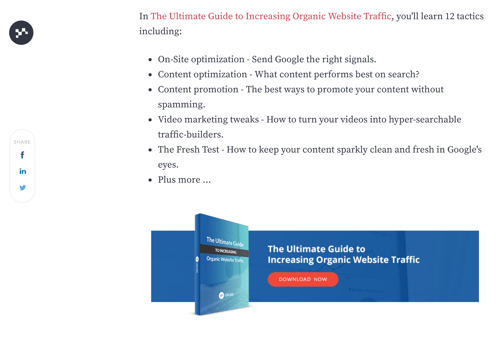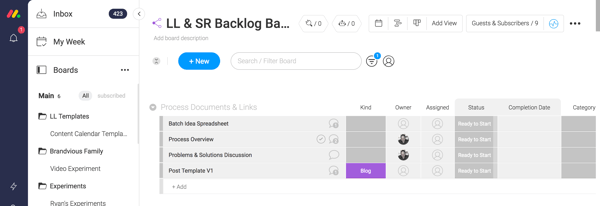Want to supercharge your rankings on Google and get a ton of traffic?
You can do it by improving your domain authority.
Why? Because of the way it impacts search rankings. The higher your domain, the more likely it is that your content will rank on Google. But as many brands know, domain authority isn't easy to build. In turn, a lot of people ignore it or don't invest enough time into it.
However, it should (and can) be a priority with the right steps. If you do content marketing the right way, you can meticulously build domain authority, rather than leaving it to fate. And, we've developed a template that helps us to consistently do just that.
The B2B Content Strategy Template We Use To Build Domain Authority
Domain Authority was originally a metric by Google. The score could be between a 1-10. Anything over four meant you were crushing it. But eventually, people manipulated domain ranking to gain artificial rankings, so Google scrapped it.
Today, website domain authority is reported by Moz. It’s a number between 1-100 that indicates how well your content will rank in the SERPs, based on how authoritative Google considers your website to be. The higher the number, the better.
It’s not perfect, but domain authority is still a great indicator on how Google views your website. You can't easily manipulate it. It's determined by the number of total links your website has, as well as linking root domains.
And although Google does not use Domain Authority to determine rank, it’s still important to work toward a higher domain authority for your website. When you actively work to improve domain authority, you can optimize your website and improve your SEO efforts to increase your chances of getting content ranked.
What Moves The Domain Authority Needle?
Three things that move the domain authority needle in Moz. You need to work on each effort constantly to move it forward, and have:
- A Generous Amount of High-Quality Content
- Regular Engagement With Your Content
- Internal And External Backlinks
The better you balance and master these three efforts, the increased chance you have at raising your domain authority.
The B2B Content Strategy Template We Use To Improve Domain Authority
There are ways to improve audience engagement with your content and increase your backlinks. But the most effective way is to have exceptional content, which we do with our internal content template.
Here is how our content template breaks down:
1. DOCUMENT YOUR CUSTOMER'S Motivation
To start, you want to find your ideal customer's motivations, challenges, and frustrations. You need to figure out what they’re searching for, and craft content that addresses these questions.
We do this by:
- Conducting Persona Research
- Determining What Questions They Ask Google
Then, we use a one-page buyer persona template to record the research.
The insights on this sheet will literally inform your keywords and blog titles. For example, under "Action Drivers" are priority initiatives such as "Improve Website Results."
Your customer is going to search for that and queries that relate to that, which is why you need to develop that content.
2. CONDUCT Keyword Research
Once you have an idea of what your ideal persona is searching for, invest in a tool like SEMrush and start looking through keywords. You can evaluate phrase match keywords and related keywords for ideas.
For instance, here's what comes up when you search for "digital camera."
You can see a ton of brand names and phrases that people search for related to digital cameras. From there, you can evaluate keywords by keyword difficulty score, as well as the monthly traffic for each keyword to determine how hard it will be to rank for it. Then, we come up with anywhere from 100-200 keywords we could potentially use.
Because you may find a few keywords you like, but realize that the phrase or word is too difficult to realistically rank for. A blend of difficult, medium, and low difficulty keywords is usually a good mix.
3. Brainstorm Titles In The Content Spreadsheet
Once you have your 100-200 keywords documented, you’ll start choosing which keywords you want to use and transfer them to a content spreadsheet.
We use a Google Drive spreadsheet template for our titles, which looks like this:
We store the title and keyword of course, but we also provide a link to the SEMrush link overview, topic cluster, traffic volume, difficulty score, as well an impact and confidence score, which is a score we assign on how likely we think the article is to rank.
The volume, difficulty, impact, and confidence all calculate to a score. You can use the same formula in Google Drive: =sum(COLROW:COLROW)/3/10.
4. Determine What Funnel Pieces We Need
Another critical component of a well-rounded content strategy is your funnel pieces. Funnel pieces are content assets and offers that align with various stages in the buyer journey.
Let’s look at how new visitors typically become leads on a website as an example.
For example, let's say I visit the Lean Labs website for the first time after searching for “increasing organic traffic.”
I find this post, How to Increase Blog Traffic: Our A to Z Workflow and Tool List, through Google. I read through the post, which gives a lot of great tips and advice for increasing my blog traffic.
What’s the next logical step for me?
How about an ebook that goes into more depth about increasing website traffic?
On this blog post, that’s exactly what the CTA is for.
This guide, The Ultimate Guide to Increasing Organic Website Traffic, is a funnel piece. It helps guide website visitors through the funnel. After they click on the CTA and complete the form to get the ebook, they become a lead. And this piece, amongst other content assets, help inspire blog content.
I can take one concept from the ebook, flesh it out into a blog article, and guide the reader back to the asset. They get great content, and we get a lead.
5. Create Batches Of Articles
It can be challenging to plan your content production, but something that helps us is batching blog content. Each of our batches consists of four articles. None of the content is delivered until each article in the batch is complete.
And each article is based on three things:
1. Questions From The Buyer Persona
2. Keywords We Found From SEMrush
3. A Connection To One Of Our Lead Magnets
All of these aspects are important because they help us connect with our potential customer, potentially get traffic from Google, and provide our reader with a next step that makes sense in the context of the article.
From there, you want to use some content software, (we use Monday.com), to keep batches organized.
Working Toward A Better Domain Authority
At the end of it, building domain authority is all about having a consistent content marketing plan. And in our experience, the best content marketing is paired with a strategy to help distribute content, as well as attract and nurture leads. Of course, this is called an inbound marketing strategy.
With an inbound marketing strategy, you can nail all of the best practice of creating content, getting external backlinks, organizing the content on your site, as well as getting regular engagement from content assets. To learn more about how to create a robust inbound marketing strategy, check out our eBook, Conquering The Inbound Marketing Mountain.











